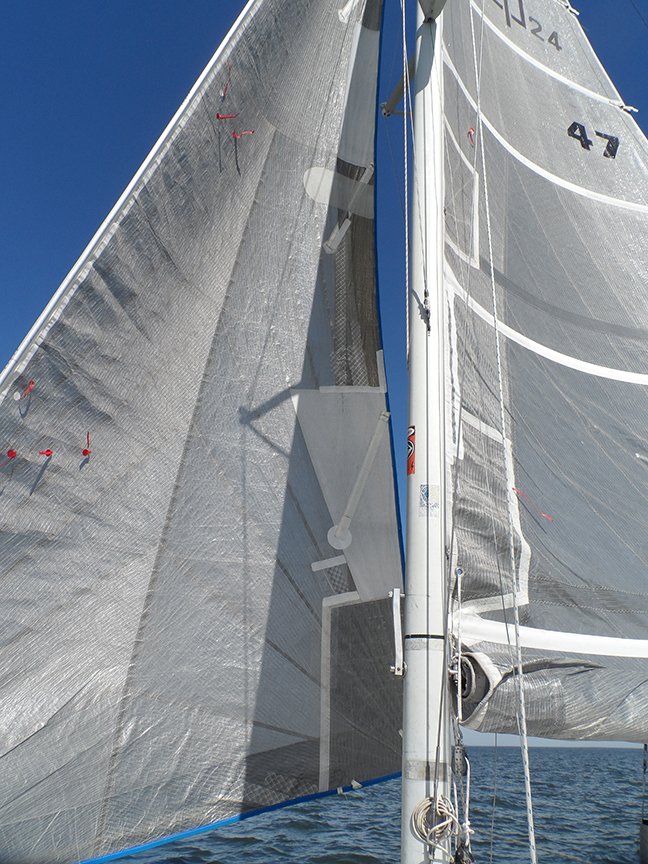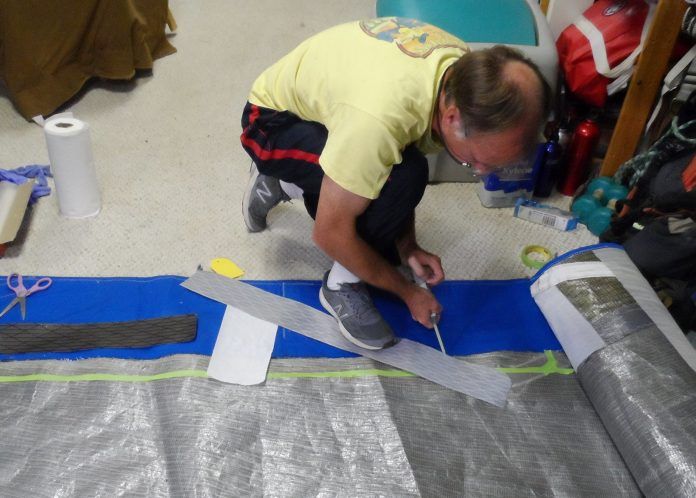If you’re going to sail you’ll be doing some stitching-no two ways about it. That doesn’t mean you have to go overboard with sail repair tools. Don’t jump into the $100 do-everything kit. Start with a modest kit, adding tools and materials only as your skills grow and projects require them. Chances are, you already have most of what you need in your other supply lockers or tool boxes.
Work surface – A wooden cutting board is perfect for small projects, much better than plastic.
Sailmaker’s palm – Get one that fits. Left-handed palms are available. A Dremel can smooth out the sharp edges, so your palm is as soft as a true sailmakers palm.
Needles – Get an assortment, size 12-18. Smaller numbers are larger needles. A number 16 is a good match for #4 whipping twine, your workhorse thread.
Waxed whipping twine – You can wax as you go, but pre-waxed is handier. Robline #4 is our favorite. It is heavier than machine thread, so it will last longer. And it’s strong enough that if you double it, you don’t need to back-fill in each zig-zag stitch. Heavier twines are used for webbing and around eyes, but for field repairs you can just use more strands of #4. Get a few spools; white is good for sails, dark colors are handy for marking lines.
Thread – Gore Tenara is the thread of choice among sail canvas shops, has outstanding UV resistance, but it can allow water to drip through some fabrics like Top Gun (see “Winter Covers: What to Look For“).
Safety pins and straight pins – You’ll want these for holding fabric. Double-stick seam tape helps, but if you’re working in the wind or in tight spaces, pins seem to work better.
Awl or icepick – This is essential for forcing holes through material to stiff for palm or even stitching awl alone.
Stitching awl – These tools are handy when you can’t reach to both sides, but most jobs are more easily fixed with a needle and palm.
Pliers – Sometimes the needle requires a little encouragement. The one in your toolbox is fine.
Lighter or soldering iron for sealing edges – If you can’t turn a seam under soldering the edges prevents fraying.
Cutting tools – Although a knife, razor, and seam ripper all have their place. Start with a good pair of sharp scissors.
Materials – Some scraps of sailcloth and canvas are useful, but webbing, soft leather or elk hide, Sunbrella, and sail repair tape are just as essential.
Fids – Handy for loosening knots and splicing, get a standard fid before you start coveting all of the fine implements for splicing double braid (see “A Fistful of Fids, PS July 2006).

Wool yarn – Tell tales are perhaps the most common item, and though other materials fly more easily, wool seems to dry fastest and not get stuck to the sail. Some attach them with sail tape. You can also thread them through the tiniest possible hole with a knot on each side. Instead of struggling to thread fat yarn through a small needle (hint, push the needle onto the thread), thread a double strand of light thread through the needle, lasso the thick thread and bring it back through (See Adding Telltales to Your Sail, PS May 2018).
Household needles and thread – Include an assortment of smaller needles and thread for repairs to upholstery and clothing. White and several colors in heavier weights.
Fasteners – Once you head offshore it’s good to have a few grommets and a grommet kit, as well as some spare fasteners.
Practice – If you can find nothing that needs fixing, splice and stitch a loop at each end of a short piece of old double braid-about a foot will do-you’ll find plenty of uses for it.
For more details on the skills and materials for repairing laminated sails, see our follow-up report on fixing laminate sails in the May 2019 issue of Practical Sailor.
For more tips on sail repair and more, check out two of our favorite books on sails: The Sailmakers Apprentice, by Emiliano Marino, and Maximum Sailpower, by Brian Hancock. For a comprehensive look at sail selection, design and repair, check out our online bookstore and Practical Sailor‘s 4-part series “A Look at Sails,” available at the online bookstore.
For materials and supplies, including heavy duty sewing machines, Sail-rite is an excellent one-stop resource for all the cruising sailor’s sailmaking and canvas work needs.








































“ stitch a loop at each end of a short piece of old double braid-about a foot will do-you’ll find plenty of uses for it” …. Such as?
Would you PLEASE hire (or have a trustworthy & well read friend) Proofread Every Item you release!!
The current printed issues could benefit as well!
It is no small thing to act professional if you wish to be considered as such.
I find myself having to repeat my request noted above! You should Always -Slowly- read one’s own text; and then have it reviewed by a competent party.
Your mag is not the only one with issues… but they are frequent and undermine the great care that was; and still is(?) the hallmark of Practical Sailor.
Having had a mother who was also an English teacher, I concur. Quite often I see (and this seems to be common to many magazines) where a word has been left out, or the wrong word is used. Spell check doesn’t catch those errors; only a close proof read will.
Otherwise it is a fine source of information, and I thank you for the effort you put into printing it.
Very helpful, thanks
As a University Professor, I can tell you all that millennials (if any are writing or editing your copy) are the source of your editing problems. You can’t learn to write properly I watching YouTube videos.